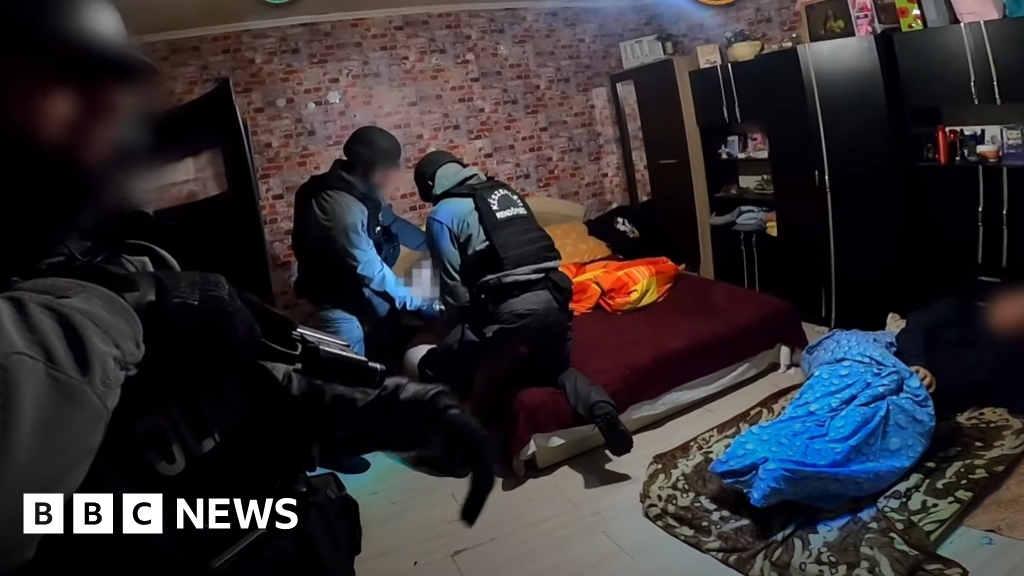ARTICLE AD BOX
Last week, an Indian man was given a rare double-life sentence for killing his wife by making a cobra bite her. Soutik Biswas and Ashraf Padanna piece together the events leading to the grisly murder.
In April last year, 28-year-old Suraj Kumar paid 7,000 rupees ($92; £67) for a spectacled cobra, one of the most venomous snakes in the world. Trade in snakes is illegal in India, so Suraj made the clandestine purchase from a snake catcher, Suresh Kumar, in the southern state of Kerala.
Suraj drilled a hole in a plastic container for air to flow in, put the cobra inside, and took it home.
Thirteen days later, he put the container in a bag and trudged to his in-laws' home, about 44 km (27 miles) away, where his wife Uthra was recovering from a mysterious snake bite.
Suraj and Uthra had met two years earlier, via the services of a matrimonial broker. Suraj's father was an auto-rickshaw driver and his mother a homemaker. Uthra, who was three years younger than Suraj and suffered from learning disabilities, came from a significantly more well-off family - her father a rubber trader and mother a retired school principal.
When the couple married, Suraj accepted a dowry from Uthra's parents of 768 grams of gold (worth about $32,000 at today's rates), a Suzuki sedan and 400,000 rupees in cash. He also received 8,000 rupees a month from her parents "to look after their daughter", investigators said.
It was her parents' home Uthra returned to after being released from hospital. The snake bite had put her there for 52 days and required three painful surgeries to heal her affected leg.
She had been bitten by a Russell's viper - a highly venomous earth-coloured snake responsible for thousands of deaths in India every year.
Image source, Getty Images
Image caption, The spectacled cobra is one of the most venomous snakes in the worldThen on the night of 6 May, investigators say, while Uthra was still recuperating, she accepted a glass of fruit juice from Suraj which was laced with sedatives. When the mixture had put her under, Suraj brought out the container with the Cobra, overturned it, and dropped the five-foot-long snake on his sleeping wife.
But rather than attack her, the snake slithered away. Suraj picked it up and flung it on Uthra, but again it slithered off.
Suraj tried a third time - he held the reptile by its trademark hood and pressed its head near Uthra's left arm. The agitated cobra, using the fangs at the front of the mouth, bit her twice. Then it slinked off to a shelf in the room and stayed there all night.
"Cobras don't bite unless you provoke them, Suraj had to catch it by its hood and force it to bite his wife," says Mavish Kumar, a herpetologist.
Suraj washed the juice glass, destroyed a stick he had used to safely handle the snake and deleted incriminating call records on his mobile phone, according to investigators.
When Uthra's mother entered the room the next morning, she told the police she saw her daughter lying on the bed with "her mouth open, and her left hand dangling on one side".
She said Suraj was also in the room.
"Why didn't you check whether she was awake?" Manimekhala Vijayan asked her son-in-law.
"I didn't want to disturb her sleep," Suraj told her.
Image source, Sreedhar Lal
Image caption, Uthra slept on the bed on the left in this room where she was killedThe family rushed Uthra to the hospital, where the doctors pronounced her dead by poisoning and called the police.
The autopsy report found two pairs of puncture wounds, less than an inch apart, on her left forearm. Blood and viscera samples revealed the presence of cobra venom and sedative drugs. Cobra venom can kill in hours by paralysing respiratory muscles.
Acting on a complaint by Uthra's parents, the police arrested Suraj on 24 May in connection with his wife's unusual death. After a 78-day investigation and with charges running into more than 1,000 pages, the trial began.
More than 90 people, including herpetologists and doctors, testified. The prosecution built its case using Suraj's call records, internet history, a dead cobra exhumed from the back garden, a stash of sedatives in the family car and evidence that he bought not one but two snakes. Investigators said that Suraj had also purchased the Russell's viper which had bitten Uthra months before she died.
Suresh, the snake catcher, turned on Suraj and confessed to selling him both snakes. A herpetologist told the court that it was highly unlikely a cobra would have entered the couple's bedroom through a raised window. The crime scene was even recreated, using a live cobra, a snake handler and a dummy of the victim on a bed.
Image source, Sreedhar Lal
Image caption, Police found the plastic container in which Suraj kept the cobra that killed his wife"Cobras are not very active at night. Every time we dropped a cobra on the supine dummy, it slithered to the floor and went into a dark corner of the room," Mavish Kumar said. "Even when we provoked the cobra, it did not try to bite."
He then caught the neck of one cobra and "induced" the bite on a piece of chicken tied to the plastic hand of the dummy. The distance between the bites was the same as it had been on Uthra's arm.
"This is a case of diabolical and ghastly uxoricide," said Judge M Manoj, referring to the murder of a wife. Judge Manoj sentenced Suraj to life in prison, saying he had schemed to kill Uthra and "disguise it as a death from an accidental cobra bite".
According to investigators, the fatal cobra bite was Suraj's third, not second, attempt to kill his wife in just four months.
Suraj, who worked as a collection agent for a local bank, met the snake catcher Suresh in February last year, and bought the Russell's viper from him for 10,000 rupees. He took the snake home in a plastic container and hid it under a heap of firewood in a shed.
Then on 27 February, Suraj released the snake on the landing of the first floor of his home, investigators said, and asked his wife to go upstairs to fetch his mobile phone.
Uthra saw the viper coiled up on the marble floor and raised an alarm, her mother told the police. Suraj came up, picked up the snake with a stick, and left the house. He put it back in the container.
On the night of 2 March, Suraj tried again. He laced his wife's pudding with sedatives, and released the viper in the bedroom while she slept.
Image source, Sreedhar lal
Image caption, The murder took place on the ground floor of this house in Kollam districtThis time, investigators said, the snake attacked. Uthra woke up screaming in pain, bites on her leg, and Suraj threw the snake out of the window.
"Snakebite cases are common in Kerala, so we didn't suspect any foul play here," said Vijayasenan Vidhyadharan, Uthra's father. (About 60,000 people die of snakebites in India every year.)
It took more than two hours that night to find a hospital that provided critical care treatment. Uthra was suffering from swelling and haemorrhage. Three skin transplant surgeries later, she returned home to her parent's two-storey house in a verdant village in Kollam to rest.
Suraj remained with his son and parents at his home in Pathanamthitta. But he was already plotting again.
"While his wife was in the hospital, Suraj was trawling the internet about handling snakes and learning about snake venom," said Anoop Krishna, one of the investigators.
Image source, Sreedhar Lal
Image caption, Suraj (middle) had been planning to kill his wife for more than a year, police sayInvestigators say Suraj had been plotting the murder since the birth of his son, Dhruv, in 2019. His internet history revealed that he searched venomous snakes and watched snake videos on YouTube, including a channel by a locally well-known snake handler. One of the snake-handler's most popular videos is about the "dangerous and aggressive Russell's viper".
Suraj reportedly told his friends that his wife was "haunted by the curse of a serpent" in her dreams, in which she was "destined to die of snakebite".
In reality, Suraj was determined to kill his wife, steal her money, and marry another woman, investigators said.
"He planned it meticulously and succeeded in the third attempt," said Apukuttan Ashok, the lead investigating police officer. Public prosecutor Mohanraj Gopalakrishnan called the case a "milestone in police investigations in India, when prosecutors could decisively prove that an animal was used as a weapon of murder".
Suraj received a rare double life sentence for the crime. According to Gopalakrishnan, he showed no remorse.
You may also be interested in:

 3 years ago
40
3 years ago
40








 English (US)
English (US)